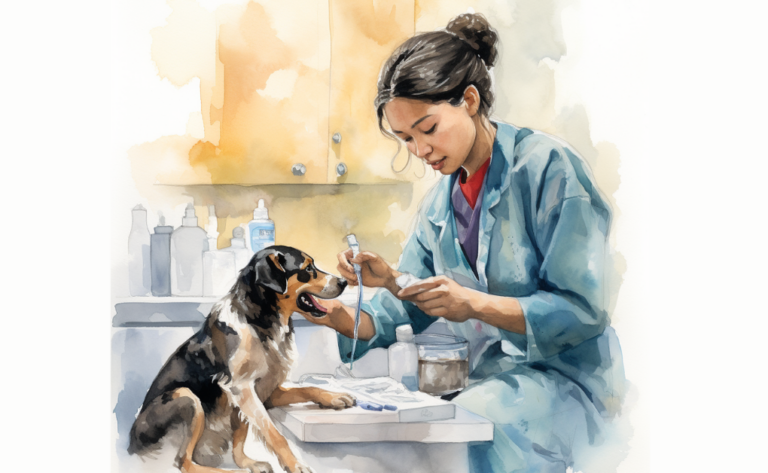What are External Parasites in Dogs?
What is it?
How is it Treated?
Breed Predispositions
There is no specific breed predisposition to external parasites in dogs. However, factors such as lifestyle, exposure to outdoor environments, and poor hygiene can increase the risk of external parasite infestations.
Introduction
Amanda had always enjoyed the bond she shared with her lively Australian Shepherd, Luna, frequently taking her on outdoor adventures through the woods and along the beach. One day, as they returned from a particularly exciting hike, Amanda noticed Luna incessantly scratching and biting her fur. Concerned, she decided to give her a thorough inspection and was shocked to discover small, unwelcome guests hiding among Luna’s beautiful coat: external parasites. In this blog post, we will delve into the world of external parasites in dogs, discussing the various types, symptoms, treatments, and preventative measures. As you read on, you’ll gain the knowledge necessary to protect your canine companion from these pesky invaders, ensuring they can continue to enjoy their outdoor escapades while remaining happy and healthy.
External parasites in dogs, distinct from intestinal parasites, refer to various organisms that infest the external body surfaces, such as the skin and hair. These external dog parasites survive by feeding on the dog’s blood or the outer skin layer, leading to various health complications, including conditions like demodectic mange. These parasites are a significant concern in canine health due to the discomfort they cause and their potential to transmit other serious diseases. Therefore, pet owners must regularly check their pets for signs of external parasitic infestation and maintain appropriate preventive measures.
Types of External Parasites
Several types of external parasites can affect dogs. Here are some of the most common:
Fleas
Fleas are external parasites that infest dogs and other mammals. They are tiny, wingless insects, about 1/16 to 1/8-inch long, with flattened side-to-side bodies, enabling them to move easily through a host’s fur. Fleas are notorious for their jumping abilities, using their long hind legs to leap onto a host.
The most common species is the cat flea, Ctenocephalides felis, which also infests dogs. Fleas feed on the blood of their hosts, and their bites can cause itching and inflammation. This reaction is even more severe in dogs with flea allergy dermatitis, leading to intense itching, hair loss, and skin infections.
Fleas can also act as vectors for several diseases. For example, they can transmit tapeworms to dogs and occasionally to humans. They can also carry a host of bacterial diseases, such as bartonellosis.
Flea infestations can be prevented and treated with various products, including topical treatments, oral medications, sprays, and collars. Some products kill adult fleas, while others target other flea life cycles stages like eggs and larvae. Your veterinarian can recommend the best product for your dog’s situation.
Ticks
Ticks are another common external parasite that can infest dogs. They belong to the arachnid family and are larger than fleas, making them easier to spot on your dog’s skin. Ticks are found in wooded and grassy areas and attach to dogs when they pass by.
Ticks are blood-sucking parasites, and their bites can cause irritation and infection. However, the primary concern with ticks is not the bite itself but the diseases they can transmit while feeding. Ticks are known vectors of several diseases that can affect dogs, such as Lyme disease, ehrlichiosis, and anaplasmosis. Some of these diseases can also affect humans, making tick control important for the entire household’s health.
Ticks attach firmly when feeding and must be removed carefully to avoid leaving the mouthparts embedded in the skin. Using a pair of tweezers or a special tick removal tool, the tick should be grasped as close to the skin as possible and pulled straight out with steady, even pressure.
Mites
Mites are tiny external parasites that can infest dogs, causing various skin conditions. Several mites can affect dogs, each causing a specific condition with different symptoms.
- Sarcoptic Mange (Scabies): This condition is caused by Sarcoptes scabiei mites. These microscopic parasites burrow into the skin, causing intense itching, redness, sores, and hair loss. Scabies is highly contagious among dogs and can also be transmitted to humans.
- Demodectic Mange (Demodicosis): This condition is caused by Demodex mites. These mites live in the hair follicles and are usually harmless. However, in dogs with a compromised immune system, the mites can multiply and cause skin inflammation, hair loss, and secondary skin infections. Unlike scabies, demodicosis is not contagious.
- Ear Mites: Ear mites, most commonly Otodectes cynotis, commonly cause ear infections in dogs. These mites live in the ear canal and cause inflammation, itching, and a dark, coffee-ground-like discharge. Ear mites are highly contagious and can easily spread between dogs and cats.
Regular grooming, proper nutrition, and maintaining your dog’s health can help prevent mite infestations. If you suspect your dog has a mite problem, consult your veterinarian for a proper diagnosis and treatment plan.
Lice
Lice are small, wingless insects that infest the hair and skin of dogs. They are species-specific, meaning dog lice will not infest humans and vice versa. However, lice in dogs can cause severe itching, hair loss, skin inflammation, and in severe cases, anemia due to blood loss.
Two types of lice can affect dogs:
- Chewing lice: These lice, known as Trichodectes canis, feed on the skin debris, sebum, and hair of dogs. They are more common in dogs with poor health and hygiene conditions.
- Sucking lice: These lice, known as Linognathus setosus, attach to dogs’ skin and feed on their blood. They are less common than chewing lice but can cause more serious health issues due to blood loss.
Lice infestations, or pediculosis, are relatively rare in dogs, especially those well-cared for and regularly groomed. They are more commonly seen in dogs that are neglected, strays, or those living in crowded conditions.
Lice can be easily seen with the naked eye and are typically found close to the skin, attached to the hair. They lay their eggs, or nits, on the hair shafts close to the skin.
Flies
Flies, specifically a variety of biting flies, can cause discomfort and potential health issues in dogs. While most flies are merely nuisance pests, some species, such as the stable fly and deer fly, can bite and feed on the blood of dogs.
- Stable Flies: Also known as “dog flies,” stable flies are similar in appearance to the common house fly but feed on the blood of dogs. They typically target the dog’s ears and can cause painful bites.
- Deer Flies: These flies are not as common as stable flies, but their bites are quite painful. They can cause itching, redness, and swelling in dogs.
- Black Flies: Also known as “buffalo gnats,” these flies are small, but their bites can cause significant irritation, swelling, and even an allergic reaction in some dogs.
- Sand Flies: Found in tropical and subtropical regions, these flies are vectors for a serious parasitic disease in dogs known as Leishmaniasis.
Flies can also lay eggs on a dog’s skin, which can hatch into larvae and cause a condition known as myiasis, more commonly known as “maggot infestation.” This is more common in dogs with open wounds or severely neglected.
Causes of External Parasites in Dogs
Different factors can precipitate a parasitic infection, leading to issues such as external parasites in dogs:
- Poor Hygiene and Insufficient Grooming: Regular grooming and bathing can aid in eliminating and thwarting parasites. Overlooking this routine can heighten the risk of an infestation, such as mites or fleas, which could lead to severe flea infestation if not addressed.
- Absence of Preventative Steps: Dogs are more likely to attract parasites if preventative methods like consistent use of flea and tick deterrents aren’t applied.

- Diminished Immune System: Dogs suffering from a weakened immune system, possibly due to age, illness, or stress, are more prone to infestations as their bodies are less equipped to repel these pests.
- Season and Climate: Many external parasites flourish in warm, humid environments, causing spring and summer to be prime times for infestations. However, parasites such as adult fleas can pose a year-round issue in some warmer regions or indoor settings.
- Environmental Exposure: Dogs can acquire external parasites from their surroundings. Public areas like parks, kennels, and groomers provide ample opportunities for direct contact between animals, leading to the transfer of parasites. Furthermore, dogs might interact with infested animals in their backyard, including wild creatures and birds. Areas abundant in tall grass, woods, or a significant wildlife population pose an especially high risk.
- Interaction with Infested Animals: Parasites such as fleas, ticks, mites, lice, and intestinal worms can transfer directly from one animal to another. If your dog interacts with another infested pet, they risk contracting the parasites. In addition, specific issues like mite infestations, such as ear mites, can cause significant discomfort for your dog.
Remember, prevention always surpasses treatment. Regular preventative treatments recommended by your vet, good hygiene, and grooming can protect your dog from external parasites. Additionally, steering clear of high-risk areas, particularly during peak seasons, can prevent conditions like flea allergy dermatitis. Keeping these factors in mind can help cause your dog remain parasite-free
Symptoms of External Parasite in Dogs
Dogs plagued by external parasites may display a multitude of symptoms. These symptoms can vary, contingent on the type of parasite, the extent of the infestation, and the dog’s unique reaction. Some of the commonly observed symptoms include:
- Persistent Itching and Scratching: A parasite living outside the dog’s skin can cause intense discomfort, leading to constant scratching.
- Hair Loss: This can signify parasitic infestation and may signal underlying skin issues.
- Skin Redness and Inflammation: Parasites can irritate the skin, leading to inflammation and redness.
- Rashes and Sores: Parasites can invade the skin and cause skin itching, leading to rashes and sores. These can further develop secondary bacterial infections if not treated promptly.
- Flea Dirt: If your pet has flea dirt (excrement), it strongly indicates a flea infestation.
- Visible Parasites: In some cases, the parasites may be seen on the dog’s body.
- Restlessness and Anxiety: The constant irritation and discomfort can make the dog restless and anxious.
- Anemia: In severe infestations, the parasites can consume enough of the dog’s blood to cause anemia.
- Behavioral Changes: Changes in your dog’s behavior, such as reduced playfulness or increased aggression, could also signify an external parasite problem.
Remember, whenever you spot coat abnormalities or other unusual signs, you must consult your veterinarian promptly for diagnosis and treatment. First, they can determine if your dog has developed an allergy to fleas or any other parasitic infectious disease. Timely intervention can prevent the issue from escalating and being transmitted to other animals. Next, you should visit your local animal hospital or a professional who can provide the necessary treatment to keep the parasites outside the body and offer relief to your furry friend.
Diagnosis of External Parasites in Dogs
Diagnosing external parasites in dogs involves a combination of physical examination, microscopic examination, and specific tests. Here’s a brief description of each:
- Physical Examination: The vet first conducts a thorough physical examination of the dog. They look for visible signs such as redness, irritation, bald patches, flea bites, and parasites’ presence. Some parasites, like fleas and ticks, are large enough to be seen with the naked eye.
- Microscopic Examination: A skin scraping or hair pluck might be taken from the affected area and examined under a microscope. This is particularly effective for identifying smaller parasites like mites, which cause demodectic or sarcoptic mange conditions. Mite infestation, for example, can lead to generalized demodecosis, a condition where mites live and increase across the dog’s body.
- Fecal Examination: Though this method is primarily used to diagnose internal parasites, certain external parasites, like fleas, can be indirectly detected, as they might pass into the dog’s stool as larvae or eggs.
- Specific Tests: Depending on the suspected parasite, specific tests may be used. For example, a flea comb may gather flea dirt (feces), which turns red when placed on a damp white paper, indicating the presence of fleas.
- Culture and Sensitivity Testing: For persistent skin problems or suspected secondary bacterial infections, the vet may take a sample for bacterial culture and sensitivity testing.
Moreover, vets often consider the dog’s history, including whether it has been in contact with an infected animal. This is especially important for common parasites that can easily be transmitted from one animal to another.
It’s essential to consult a veterinarian to identify external parasites, as they can provide appropriate diagnosis and treatment plans.
Treatment for External Parasites in Dogs
Treatment for external parasites in dogs typically includes combining the following strategies.
Topical Treatments
Topical treatments for external parasites in dogs are a common and effective way to treat and prevent infestations. These treatments often come in spot-on applications, shampoos, sprays, or powders.

- Spot-on treatments involve applying a small amount of medication to the back of the dog’s neck or between the shoulder blades, where it can spread across the dog’s body and provide protection for up to a month. These treatments are effective against various parasites, including fleas, ticks, and mites. Although they aren’t always 100% effective.
- Shampoos and sprays are another way to treat external parasites. These are applied over the dog’s entire body, killing parasites on contact. However, the effects of shampoos and sprays are often not as long-lasting as spot-on treatments and may need to be reapplied more frequently.
- Powders can also be used to treat external parasites. Like shampoos and sprays, they are applied over the dog’s entire body, but they can be messy and less convenient.
Oral Medications
Oral medications for treating external parasites in dogs are another effective option for addressing infestations and providing protection. These medications are typically available in tablet or chewable form and are administered to the dog according to the prescribed dosage and schedule.
Some oral medications target specific parasites, such as fleas or ticks, while others provide broader coverage against multiple parasites. Common oral medications for treating external parasites include fluralaner (Bravecto), afoxolaner (NexGard), and sarolaner (Simparica).
These medications work by entering the dog’s bloodstream after ingestion. When parasites bite or feed on the dog, they are exposed to the active ingredient in the medication, killing or incapacitating the parasites. Depending on the specific product, oral medications can protect for up to a month or longer.
Collars
Parasite control collars are an effective and convenient method for preventing and treating external parasite infestations in dogs. These collars are impregnated with insecticides or insect growth regulators that either repel or kill parasites such as fleas and ticks.
When worn by the dog, the active ingredients are released gradually and spread over the skin and coat, providing several months of protection. Some collars, like the Seresto collar, can protect against fleas and ticks for up to eight months.
The collar must be worn continuously to maintain its effectiveness and should be replaced as the manufacturer recommends. It’s essential to ensure that the collar is fitted correctly – it should be snug but not too tight, with enough space to fit two fingers between the collar and the dog’s neck.
External Parasites Prevention in Dogs
Prevention is often the best approach in the battle against external parasites in dogs. However, treating an infestation can be challenging, as parasites like fleas persist off a deceased host for weeks following treatment. Moreover, prevention is typically easier to manage as part of regular senior and seasonal pet care and can deter heavy infestations that may result in serious skin conditions.
The prevention of external parasites in dogs encompasses several proactive measures to ensure the well-being and comfort of your four-legged companion:
- Routine Veterinary Visits: Consistent check-ups with your vet are essential in identifying potential problems early on. Your vet can provide parasite prevention advice and administer preventive treatments.
- Maintaining Clean Surroundings: Regularly cleaning your home, yard, and dog’s bedding can help deter infestations. Frequently vacuuming and washing your dog’s bedding can decrease the likelihood of fleas, ticks, and mites.
- Implementing Preventive Treatments: Monthly preventive treatments such as topical applications, oral medications, or parasite prevention collars can help avoid infestations of various parasites, including ticks. Your vet often has these treatments available.
- Regular Grooming: Grooming your dog regularly keeps them looking neat and allows you to inspect their skin and coat for signs of parasites. Practices like ear cleaning and using a flea comb when grooming your dog can help remove and prevent parasites.
- Balanced Nutrition and Regular Exercise: Healthy and young dogs are less likely to experience a severe infestation. A balanced diet and regular exercise can bolster your dog’s immune system, rendering them less prone to parasites.
- Avoiding High-Risk Areas: Avoid environments that harbor large parasite populations, such as tall grass, marshy regions, or areas teeming with wildlife.
Always remember that prevention is the most potent weapon against external parasites. Therefore, regularly monitoring your dog and implementing these preventive actions can help maintain your pet’s health, avoiding pet emergencies related to parasites.
Frequently Asked Questions
Disclaimer: The information provided on this veterinary website is intended for general educational purposes only and should not be considered as a substitute for professional veterinary advice, diagnosis, or treatment. Always consult a licensed veterinarian for any concerns or questions regarding the health and well-being of your pet. This website does not claim to cover every possible situation or provide exhaustive knowledge on the subjects presented. The owners and contributors of this website are not responsible for any harm or loss that may result from the use or misuse of the information provided herein.







